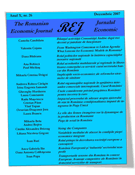Abstract:
Every organization is faced with uncertainty and risk. The challenge for management is to determine how much uncertainty to accept as it strives to improve stakeholder value. Risk identification is a process designed to identify first both the strategic objectives and goals and then the potential internal and external events that can adversely affect the enterprise’s ability to achieve those objectives and goals. Enterprise risk management (ERM) has been recognized as being one of the most important issues in business management in the last decade. ERM includes the methods and processes used by organizations to minimize surprises and seize opportunities related to the achievement of their objectives. ERM is an approach to aligning strategy, process, and knowledge in order to curtail surprises and losses as well as to capitalize on business opportunities. In order to provide the materials and the technical support, we presented the role of the ERM. The paper has a theoretical value thus presenting the main concepts and notions related to ERM. The contributions presented in this paper consist mainly in the identification of the elements of ERM which although is a relatively new concept has aroused particular interest and research in the field is very consistent, however the manner of approach may be different (what we tried to do and presented in the following two chapters considered some unusual elements on ERM).
